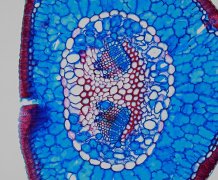Articles

Image courtesy of the Swiss Federal Research Institute WSL
Increased atmospheric carbon dioxide makes trees use water more efficiently
The increase in atmospheric CO2 concentration has allowed trees across Europe to use their available water resources more efficiently, new research has shown.
Over the course of the 20th century, the so-called water use efficiency has risen nearly 20% from the increase in atmospheric CO2 concentrations.
These results, produced by an international research team, including experts from the University of Exeter, are reported in leading scientific journal Nature Climate Change.
Trees take up carbon dioxide from the air through tiny pores on their leaves called stomata and they lose water through these same pores.
When the CO2 concentration in the air increases, the size of the stomatal opening reduces to regulate the amount of carbon acquired which minimises the water lost. As a result the so-called water use efficiency increases.
In this study the researchers used measurements of carbon from tree-rings and computer models to quantify tree and forest responses to both climate variation and increased atmospheric CO2 concentrations.
“Tree-ring data provide one of the unique opportunities to obtain long-term records of ecosystem responses to climate change”, said David Frank, a Dendroclimatologist at the Swiss Federal Research Institute WSL and collaborator at the Oeschger Centre for Climate Change Research, University of Bern.
The researchers used data from 23 tree ring sites spanning Morocco to Norway to quantify variation in water use efficiency – the amount of water required to produce a given amount of carbon – and a basic measure of plant and ecosystem economy.
Professor Pierre Friedlingstein, Chair of Mathematical Modelling of Climate Systems at the University of Exeter and one of the authors of the report, said: “The observed water use efficiency increase, in response to atmospheric CO2 increase, is something we are able to reproduce with global vegetation models giving us more confidence in the whole ecosystem response to CO2.
“However, our models simulation also indicate that globally, other drivers, such as climate change and land use change, also impact on the plant hydrological cycle.”
“By measuring the ratios of heavy to light carbon isotopes of tree-ring cellulose we are able to reconstruct various physiological metrics such as water use efficiency and their environmental drivers”, said Kerstin Treydte co-author of this study and a specialist in tree-ring isotopes at the WSL.
On average, 100 kilograms of water released by a tree through the stomata equates to one kilogram of tree biomass created. The study showed that reduced stomatal opening increased water use efficiency by 14% in broadleaf species and by 22% in needleleaf species.
Despite the CO2 induced stomatal closure, the models showed that the consequences of a warming climate - lengthened growing seasons, increased leaf area and increased evaporation - resulted in a 5% increase in forest transpiration – the cycle of water through trees. This increase cancels out any savings in water from improved efficiency. Plants are therefore unlikely to reduce levels of atmospheric water vapour – an important greenhouse gas. It is also unlikely that plant responses to increased CO2 will substantially increase soil moisture or river run-off.
Date: 12 May 2015
